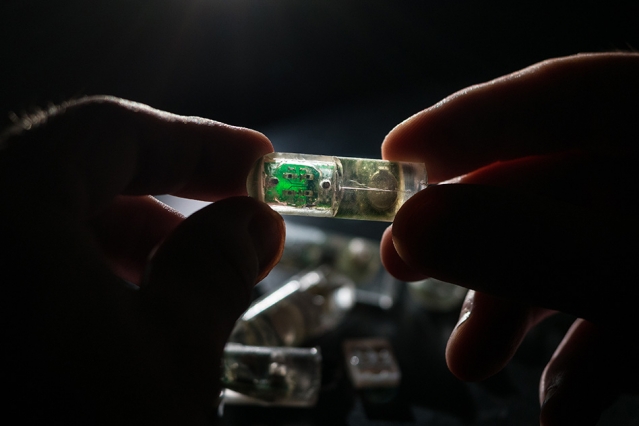25 May 2018. Biomedical engineers designed a sensor chip small enough to be swallowed, which in tests with pigs shows it can detect indicators of disease in the gut and transmit its readings to an external device. A team from Massachusetts Institute of Technology describes the device and test results in today’s issue of the journal Science.
The researchers from the Synthetic Biology Group at MIT, led by engineering professor Timothy Lu, is seeking better tools for monitoring the health of the human gut, which is becoming a more important focus of diagnostics and therapies. The lab applies principles of electrical engineering and computer science to biological systems, in this case designing a genetically-modified probiotic bacteria to act as a sensor in the gut.
The researchers also took advantage of advances in miniature biological systems by Anantha Chandrakasan, co-senior author of the paper and dean of MIT’s engineering school. As reported in Science & Enterprise in February 2017, Chandrakasan and colleagues developed and tested in animals a tiny ingestible device that ran for days powered by acids in the stomach.
In the new study, the researchers genetically engineered a benign form of E. coli bacteria to act as the sensing mechanism. The microorganisms are designed to resemble probiotic cultures considered beneficial to gut health, and also engineered to emit light when in the presence of the target molecules. In this case, the targets are heme molecules found in the blood protein hemoglobin that contains the pigment giving red blood cells their color. Because heme is a characteristic of blood, detecting its presence serves as an indicator of the sensor encountering blood.
The MIT team designed the chips with engineered bacteria in 4 carrier units, covered by semi-permeable membranes that allow molecules they encounter to pass through. When the bacteria encounter heme molecules, they emit light, which is measured by phototransistors attached to the bacteria units. The light measurements are then sent by a wireless transmitter to readers outside the body, on a laptop computer and smartphone in this case, with an Android app written to display the results. The device is powered with a tiny internal battery, but the researchers say they could adapt the earlier technology that captures electrical energy from stomach acids.
In proof-of-concept tests, the team evaluated prototype devices in 6 pigs to detect gastrointestinal bleeding. The pigs were given liquid food solutions both with and without blood added, then given the sensor devices through an endoscope into the stomach. The devices detected the extra blood in less than an hour in some cases, with the sensors’ readings shown on the external displays.
The researchers say the sensor devices can be modified to detect other disease indicators. In lab tests, for example, the team tested sensors for detecting biomarkers of gut inflammation, such as found in colitis, and infectious gut bacteria. “By combining engineered biological sensors together with low-power wireless electronics,” says Lu in a university statement, “we can detect biological signals in the body and in near real-time, enabling new diagnostic capabilities for human health applications.”
Lead authors Mark Mimee and Phillip Nadeau tell more about the devices in the following video.
- Univ. Licenses Barrett’s Esophagus Detection Device
- New Urinary Tract Infection Diagnostic Gains Funding
- Wearable Devices Explored to Detect Emotional States
- Technique Devised to Monitor Blood Flow in Brain
- Implanted Sensor Monitors Alcohol in Body
* * *


 RSS - Posts
RSS - Posts
You must be logged in to post a comment.